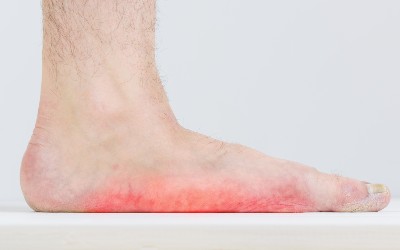Wondering Why Your Feet Feel Achy or Tired?
If your arches seem lower than they used to be, or if you're feeling persistent foot pain, you might be experiencing progressive flatfoot, also known as adult-acquired flatfoot deformity (AAFD) or pes planus. Whether you’ve had flat feet since childhood or developed them as an adult, expert care from an orthopedic foot and ankle surgeon can help you move more comfortably and confidently.
What Causes Flat Feet?
While most children are born with flat feet, a normal arch usually forms by age two or three. Over time, however, changes in the tendons and ligaments—especially with increased body weight, repetitive stress, or injury—can lead to adult-onset flatfoot.
“Each time you take a step, the force on your feet is two to three times your body weight,” says Jeffrey Levy, D.O., a fellowship-trained orthopedic foot and ankle surgeon with Riverside Orthopedic & Sports Medicine Specialists. “If you also spend a lot of time on your feet, the tendons and ligaments may stretch. Your arches may settle, and your feet appear to be flatter.”
This condition can progress gradually and become painful, especially when the posterior tibial tendon—a key stabilizer of the arch—becomes strained, torn or inflamed.
“This tendon runs from your calf, stretches down behind the inside of the ankle and attaches to the bones in the middle of your foot. It holds up your arch and supports you as you step off your toes and walk,” explains Dr. Levy. “If this tendon is torn, inflamed or stretched too much, your arch falls. You feel pain in the inner ankle.”
Who’s at Risk for Progressive Flatfoot?
Progressive flatfoot most often affects adults, particularly women over 50, but anyone can develop the condition. Factors that increase your risk include:
- Obesity or significant weight gain (including during pregnancy)
- Diabetes or high blood pressure
- Previous ankle fracture or injury
- Steroid injections near the joints, which can weaken ligaments
- Inflammatory arthritis (like rheumatoid arthritis, Reiter’s syndrome, or psoriatic arthritis)
- Genetic predisposition or family history
- High-impact activities like running or jumping sports
Athletes, especially runners, are vulnerable to tearing the posterior tibial tendon, resulting in flatfoot pain and instability.
Symptoms of Progressive Flatfoot (Pes Planus)
People with progressive flatfoot may experience:
- Tired, achy or painful feet—especially around the arch or inside ankle
- Swelling along the inner foot and ankle
- Difficulty walking, standing on toes or maintaining balance
- Pain that spreads to the lower leg or outer foot over time
- Loss of flexibility and foot alignment
Diagnosing Flat Feet and Posterior Tibial Tendon Dysfunction
Diagnosis starts with a thorough physical exam and a review of your medical history. Your orthopedic specialist may:
- Examine your feet while standing to observe arch height and alignment
- Ask you to rise on your toes or shift weight from side to side
- Check for weakness or instability in the posterior tibial tendon
“Typically, we’ll ask you to stand on your bare feet and look at how your foot functions. As flatfoot progresses, the front of the foot will slide to the outside,” says Dr. Levy. “We may also ask you to stand on your toes or rise up on your heels. We’re looking for any dysfunction of the posterior tibial tendon.”
Imaging tests like X-rays, ultrasound or MRI may be used to assess the degree of deformity or tendon damage.
Nonsurgical Treatment for Flat Feet
If you're diagnosed in the early stages of flatfoot deformity, your doctor may recommend conservative treatment to relieve symptoms and slow progression:
- Rest and activity modification to reduce strain
- Nonsteroidal anti-inflammatory drugs (NSAIDs) for pain relief
- A rigid boot or cast to immobilize the foot for 6–8 weeks
- Physical therapy to stretch and strengthen supporting muscles
- Custom orthotics or shoe inserts to support the arch and redistribute pressure
These therapies can often relieve flatfoot pain without surgery—especially when initiated early.
Surgical Solutions for Advanced Flatfoot Deformity
When nonsurgical options fail to provide relief, flatfoot reconstruction surgery may be recommended. This procedure is highly personalized and often involves multiple surgical techniques to restore foot alignment and function.
Your foot and ankle surgeon may:
- Clean and debride the inflamed posterior tibial tendon
- Realign the heel bone to correct hindfoot positioning
- Transfer tendons to replace damaged ones
- Reconstruct the arch by reshaping or repositioning bones
- Fuse joints to prevent further collapse and stabilize the foot
“These procedures are selected based on the extent of the deformity and your unique anatomy,” explains Dr. Levy. “Our goal is to restore the arch, reduce pain, and prevent the condition from worsening over time.”
Get Relief from Flatfoot Pain with Expert Care
Whether you're managing early arch pain or facing more advanced flatfoot deformity, Riverside’s foot and ankle specialists are here to help. An accurate diagnosis and tailored treatment plan can make a lasting difference in your comfort and mobility.
To schedule a consultation with Dr. Jeffrey Levy, call 757-534-9988 today.



